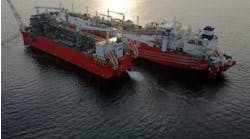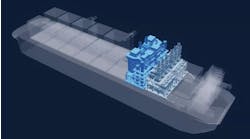Challenges linked to welding, complex riser system
Cesar Bartz
Subsea 7
Subsea 7 did the pipeline installation for the Parque das Conchas (BC-10) development, offshore Brazil. Parque das Conchas is operated by Shell on behalf of the BC-10 Joint Venture (Shell 50%, Petrobras 35%, ONGC 15%).
Located 120 km (75 mi) southeast of Vitória, Brazil, north of the Campos basin, the Parque das Conchas in block BC-10 comprises four fields: Ostra, Abalone, Nautilus, and Argonauta. Water depths range from 1,700 to 2,050 m (5,577 to 6,726 ft).
First production from BC-10 started about one year ago, and plans are for it to ramp-up to include nine producing wells and one gas injector well. The FPSOEspírito Santo serves the field and is capable of producing 100,000 b/d of oil and up to 3.5 MMcm/d (123.6 MMcf/d) of natural gas.
The Subsea 7 scope of work for BC-10 included:
- Fabrication and installation of 11 flowlines in a total of approximately 130 km (81 mi) including three gas pipelines and eight oil pipelines
- Fabrication, welding, and installation of seven Steel Lazy Wave Risers (SLWRs) totaling 21 km (13 mi)
- Transportation and installation of three dynamic and two static umbilicals totaling approximately 55 km (34 mi)
- Installation of four manifolds
- Manufacture and installation of 25 rigid jumpers
- Installation of over 60 flying leads.
Most of the company’s technical challenges were linked to welding and AUT inspection, pipe wall thickness variation, and the overall challenge to build a complex riser system for ultra deepwater.
Extensive engineering
Installation analysis for the BC-10 pipelines and welding development for fabrication of the pipelines was a challenge technically. Several finite element analyses (FEA) ensured the reeling and straightening process would not reduce the fatigue life of the risers.
Matching the large wall thicknesses variation with the fabrication tolerances of the linepipes led to individual measurement of all pipe ends and segregation of several dimensional groups of the same riser. Following grouping, all riser bores were machined to tight tolerances to allow a maximum high-to-low down to 0.5 mm.
The process of treating each linepipe as an individual item on a huge fabrication list was performed for 15,000 pipe joints. Over 15 months, the BC-10 pipes were received, measured, grouped, machined, welded, inspected, and field-joint coated in what has been to date, the largest reeled steel pipeline installation project in Brazil.
Subsea 7 worked to strict technical requirements on the SLWRs; with enormous stress to be exerted on the risers, the welding had to meet the required quality to assure the 30-year field design lifecycle. This was achieved by using automatic tungsten inert gas (TIG) welding.
Vessels mobilized
Subsea 7’s flagship vessels, theSeven Oceans, a rigid reeled pipelay vessel and the Seven Seas, a pipelay and construction vessel, were important in the success of BC-10 operations.
Delivered in 2007, theSeven Oceans is designed to operate in deepwater globally. The 157-m (515-ft) long vessel is fitted with a main reel capable of carrying 3,500 metric tons (3,858 tons) of rigid steel pipe that itself weighs 1,000 metric tons (1,102 tons); a pipelay tensioner with a 400-metric ton (441-ton) capacity; a 400-metric ton capacity deepwater crane; and an ability to lay pipe in water depths of up to 9,000 ft (2,743 m). A lay ramp system is installed permanently for deployment of rigid pipelines between 6-16 in. The vessel can accommodate up to 120 crew.
Delivered in 2008, theSeven Seas is sister to the Seven Oceans, but rather than having a rigid reel and lay tower, it has a versatile multi-lay tower and twin under-deck carousels. With a top tension capacity of 400 metric tons, the vessel can operate in flexlay and rigid J-lay mode in water depths of up to 3,000 m (9,842 ft); enabling Subsea 7 to offer J-lay for the first time.
In addition, its 1,750-sq m (18,837-sq mi) deck area and 400-metric ton crane mean it can install large structures associated with deepwater subsea field developments.
The vessels had extensive work scopes and 770 vessel days were consumed to complete the project. Installation also was supported by theSeisranger ROV support vessel over 278 vessel days.
Seisranger is a multi-purpose offshore support vessel with a primary ROV function. The main workclass ROV can operate in up to 2,000 m (6,562 ft) of water, deployed through the vessel’s centreline moonpool.
Operations begin
While 75 km (47 mi) of 12-m long (39-ft) coated X-60 and X-65 steel linepipes were being joined to form 1-km long (0.6-mi) stalks in Subsea 7’s Ubu spoolbase near Vitória, umbilicals were being loaded onto theSeven Seas in Florida for the trip to Brazil. The vessel arrived in Brazil in October 2008 to start the installation.
TheSeven Seas’ scope of work included installing:
- Two artificial lift manifolds and two production manifolds with a maximum weight of 231 metric tons
- Three dynamic and two static umbilicals totaling approximately 55 km (134 mi) – this was the first time Subsea 7 had installed umbilicals of such large outer diameter (220 mm or 82⁄3 in.) in such deepwater – up to 2,050 m (6,726 ft)
- 25 rigid jumpers – one of the largest ever subsea jumper installations campaigns
Manufacturing the rigid jumpers was another challenge as this was the first time it was ever done in Brazil.
Designed to connect the wells to the manifolds and pipelines, the 25 jumpers required a special area within the Companhia Portuária de Vila Velha facilities at the Vitória Port, Espírito Santo, to allow for fabrication of the required length. The jumpers were manufactured and tested prior to transport for installation.
To be certain the jumper dimensions were correct, detailed metrology and pre-installation tests were conducted at the fabrication base by reproducing the actual dimensions for fabrication. Consequently, each jumper was installed and fitted due to control of the dimensions and connector angles.
TheSeven Oceans arrived in Brazil in early October 2008. The spooling activities took place at Subsea 7’s Ubu spoolbase where the SLWRs and flowline stalks were fabricated and stored.
On sailing to the BC-10 site that October, theSeven Oceans began to install the SLWRs and flowlines, laying the lines from the Pipeline End Terminations (PLETS) towards the FPSO. In total, the vessel made 12 trips over the offshore campaign.
Assembly of the SLWRs was complex. In the 3 km (1.9 mi) length of the dynamic section of the pipeline, several items had to be installed.
In all seven risers, a total of 257 buoyancy modules weighing 2 metric tons (2.2 tons) each were installed to form the lazy-wave arches. The quantity varied from 25 buoys in the 6-in. gas export riser to 77 buoys in the 10-in. oil production riser. In each riser, a total of 1 km of strakes and 200 m (656 ft) of fairings were installed to suppress vortex induced vibration.
A milestone for theSeven Oceans was the installation of the flex joints. The installation engineering of the joints was complex.
Work started with the positioning of the first of three forged pieces in the vessel’s work station and continued until completion and transfer of the flex joint and riser to the FPSO.
Over eight months theSeven Oceans installed the entire subsea pipeline system including transfer of the SLWRs and flex joints to the FPSO.







